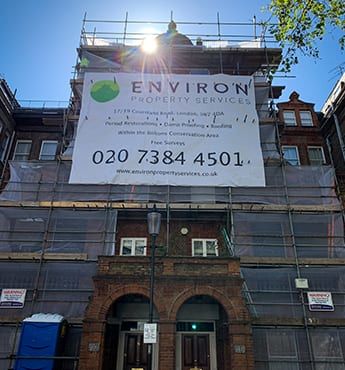What does Section 20 mean for freeholders, property managers and landlords?
Section 20 doesn’t make a distinction between landlords, freeholders, Right to Manage Companies, Resident’s Management Companies and any other management company with responsibility for the freehold. In the language of the legislation, all the above are referred to as “landlords”, and in the following guide we will do the same.
If you want to carry out works to repair, maintain or improve a property that you are the freeholder of, you need to know about Section 20. Should you ask for more than a £250 contribution towards the works from any of your leaseholders, you must follow strict Section 20 procedures.
Section 20 also applies to long-term maintenance contracts where the contribution exceeds £100 for any leaseholder over the financial year.
Failure to follow Section 20 procedure, including its schedule, will cap the contributions that you can demand from leaseholders to £250 for one off works or £100 per year for long term. This is true even if it was your leaseholders who requested the works.
You should allow at least two and a half months to complete section 20 procedures. This may be frustrating if repairs are required urgently, but it’s important that you do not rush the process or you could lose a lot of money.
Why was Section 20 introduced?
Before the addition of Section 20 to the Landlord and Tenants Act, landlords could demand excessive service charges from their leaseholders or made back room deals with shady contractors to inflate the price of their quotes and then split the difference.
Section 20 introduced more control for leaseholders and complete transparency to the process of tendering contractors. Repairs, maintenance and improvements to shared buildings now have to be a collaborative process between the leaseholders and landlords.
Can landlords avoid going through Section 20 procedures?
If the leaseholders have requested that you arrange for works to be carried out, and even if they have all agreed to works you have proposed, you are still legally obligated to carry out the full Section 20 procedure.
Some landlords make the mistake of thinking that, because they are on good terms with all the leaseholders in their property and discussed the works informally, they don’t need to carry out Section 20 procedures.
But this would be a massive mistake. If one leaseholder refuses to pay for the works, you won’t be able to charge them more than £250, and then the rest won’t be happy for picking up the bill either. Or, a leaseholder could leave the building and be replaced by a new one who won’t cooperate.
The costs of failing to follow Section 20 can be devastating. Let’s say you arranged for £10,000 worth of works on a block of flats with 10 leaseholders. If you don’t follow Section 20, your leaseholders can rightfully refuse to pay more than £250, giving you just £2500 in contributions and leaving you £7,500 short.
Right to Manage Companies also fall foul of Section 20 as they assume – because they are made up of leaseholders – that it doesn’t apply to them. However, Section 20 considers RTMs as landlords who must follow the procedures just the same.
What is the Section 20 procedure for landlords?
Step one: Notice of Intention to Carry Out Works
When you begin Section 20 procedures, your first step is to write a Notice of Intention to Carry Out Works which details your proposed works or maintenance contracts and why they are required. This notice must be written even if the works are proposed by the leaseholders.
Your leaseholders then have 30 days from receipt of the Notice of Intention to Carry out Works to make comments or suggestions. Leaseholders can also nominate contractors to carry out the works, all of which must be considered for the tender process.
You can only refuse to consider a leaseholder’s suggestion for a contractor if the contractor in question is not eligible to carry out the works, for example, if they’re not carrying liability insurance.
Step two: Statement of Estimates
If an agreement has been reached to carry out the works, you must then provide your leaseholders with a Statement of Estimates, which is an estimate for the cost and timescale of the proposed works.
These estimates are gathered through a tender process with at least two contractors, with at least one nominated by you and at least one nominated by one or more of your leaseholders.
Your leaseholders then have 30 days to comment on the estimates and have a legal right to view any estimates from considered contractors which you did not include in the Statement of Estimates.
You can only refuse to consider a leaseholder’s suggestion for a contractor if the contractor in question is not eligible to carry out the works, for example, if they’re not carrying liability insurance.
Step three: Notice of Reasons
Step three can go two ways depending on which contractor you choose to perform the works.
If you choose the contractor who provided the cheapest estimate or a contractor chosen by your leaseholders, you can award the contract and move forward with the works. This will complete the Section 20 process and you can request contributions from your leaseholders.
However, if you didn’t choose the contractor with the cheapest estimate or a contractor chosen by the leaseholders, you must provide leaseholders with a Notice of Reasons which explains your decision within 21 days of entering into the contract.
The Section 20 process will complete if your leaseholders do not object to your reasons. If the leaseholders do object, they can apply to the First-tier Tribunal to determinate liability to pay and reasonableness of service charges.
Why choose Environ Property Services for your Section 20 works?
As the landlord, you are able to choose your own contractor to carry out the Section 20 works, and there’s no better choice than Environ.
Our team of skilled tradespeople and project managers have restored countless communal properties to modern standards, even in strict Conservation Areas and delicate listed buildings. We also have numerous ongoing maintenance contracts in properties in and around London.
Leaseholders are, understandably, very price conscious and are likely to push for the cheapest option regardless of quality. We are happy to meet with your leaseholders to convince them of the benefits of high quality works that last for years rather than ad-hoc fixes which will need regular repairs.
If you are interested in nominating us for Section 20 works or have any questions about the Section 20 process, call us now or request your call back.
All the above information is shared from our perspective as contractors and is not legal advice. For further information, please read the Section 20 legislation here or contact a solicitor familiar with property law.
What do landlords need to know about Section 20?
- If contributions for works from leaseholders exceed £250 (or £100 a year), the law states you must complete the Section 20 process.
- Section 20 applies even if the leaseholders requested the works or if they agreed to the works informally.
- Failure to complete Section 20 will cap contributions from leaseholders to £250, potentially costing you a lot of money.
- At least one of the contractors considered for Section 20 works must be chosen by a leaseholder or leaseholders.
- Landlords can nominate contractors but if they do not provide the cheapest quote they must justify their decision in writing.
- The Section 20 process takes around three months to complete so you should start well in advance of when works are required.






